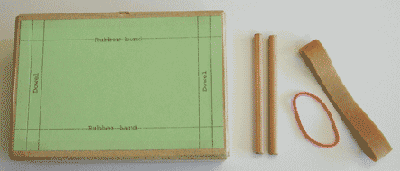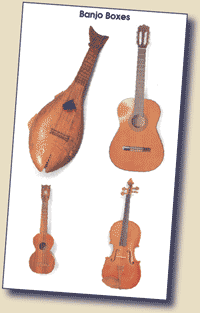| Approach: One
to one |
Level:
Year 4
and year 8 |
|
| Focus:
Sound
generation and transmission
|
| Resources:
“Banjo
box”, coloured and brown rubber bands, 2 pieces of dowel,
picture |
 |
636KB |
|
|
| Questions/instructions:
In
this activity we’ll be thinking about sounds and how they’re
made. First I’m going to make a simple banjo.
Place the box, two rubber bands and two pieces of dowling
on the table.
Teacher makes banjo box, telling the student..... |
| These
are the materials I’ll use to make a simple banjo. I put the
rubber bands around the box lengthwise. I make sure the two rubber
bands are not touching each other. Then I put the pieces of wood
under the rubber bands near the ends of the box. |
 |
|
Once
the banjo has been made give it to the student.
Now I would like you to pluck each of the rubber bands and listen
carefully to the sounds the two rubber bands make.
Allow time for student to experiment. |
|
|
%
responses
2003 ('99) |
| y4
|
y8 |
1.
What can you tell me about the sounds?
Prompt: What is different about them?
|
coloured
band makes higher sound/pitch |
54 (50) |
72
(78) |
If
the student didn’t notice that the coloured rubber band made a higher
sound than the brown rubber band, demonstrate and say,
“The coloured rubber band makes a higher sound than the brown one”. |
|
|
2.
Try to explain why the coloured rubber band made a higher sound.
|
Explanation:
[coloured band thinner/lighter;
coloured band stretched more tightly] |
|
|
included
both ideas |
9
(9) |
14
(9) |
included
thickness/mass |
75
(73) |
76
(77) |
included
tension/tightness |
4
(4) |
4
(6) |
3.
Try to explain how the sound gets from the rubber band to our ears.
|
band
makes vibrations in air which travel to ears and are heard |
14
(17) |
24
(22) |
vaguely
mentioned air vibrations |
25
(32) |
38
(50) |
4.
What do you think would happen to the rubber band sounds if we took the
pieces of wood out?
Prompt: In what way might it sound different?
|
sound
will not ring out properly,
or will stop quickly |
41
(37) |
68 (57) |
Let’s
take out the pieces of wood and see what happens.
Remove pieces of wood. |
|
|
5.
What do you notice about the sounds the rubber bands make now?
|
sound
does not ring out properly
or stops quickly |
18
(10) |
38
(45) |
difference
in pitch (lower) |
22
(20) |
20
(17) |
6.
Try to explain why the sounds are different when the pieces of wood are
taken out.
|
stops
bands from vibrating properly |
34
(29) |
53
(68) |
Show
picture of stringed instruments.
This picture shows some stringed instruments.
Notice that they all have a hole. |
 |
|
|
|
7.
Why do you think these instruments have holes in them?
|
open
cavity allows sound to resonate and amplifies sound |
15
(19) |
35
(37) |
lets
sound in/make sound louder |
31
(34) |
39
(40) |
| |
|
|
Total
score:
|
11–13
|
4
(5) |
16
(20) |
8–10
|
19
(18) |
37
(40) |
5–7
|
37
(39) |
34
(29) |
2–4
|
36
(33) |
13
(9) |
0–1 |
4 (5) |
0
(2) |
Commentary
Year 8 students, on average, performed substantially better on all task
components. There was very little change in performance between 1999 and
2003. |